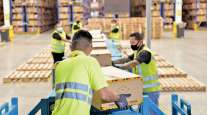Managing Editor, Features and Multimedia
E-Commerce Growth Boosting Demand for Reverse Logistics

ATLANTA — As e-commerce volumes continue to grow, customer returns of products ordered online also are rising at a rapid clip, a trend that is increasing the need for efficient reverse logistics processes to control costs.
Product returns add an estimated 7% to 11% to the base price of goods sold, and that figure is expected to rise significantly, Tony Sciarrotta, executive director of the Reverse Logistics Association, said during a panel discussion here at SMC3’s Jump Start conference earlier this year.
In the apparel industry, for example, returns rates are typically higher than 40% on e-commerce sales, he said.
“Because we’re a culture of entitlement, we’re encouraging people to buy multiple sizes, multiple colors, get them home to you, try out anything you want and send the rest back at no charge,” Sciarrotta said. “You’re going to see the cost of goods related to returns and reverse logistics go up dramatically over the next couple years.”
He defined reverse logistics as “everything that happens after the point of sale.” That includes customer support after the buyer receives the product, the return itself, product refurbishment or recycling.
The e-commerce model “is almost ensuring there will be more returns,” said panel moderator Satish Jindel, president of SJ Consulting Group Inc. and Ship Matrix.
Despite the added logistics costs incurred as a result of returns, major online retailers continue to offer customer-friendly policies on product returns.
While there might be some people who are gaming the system by using a product once and then returning it when they no longer need it, for example, the vast majority of customers who return products do so because they are not satisfied with the item they purchased, said Sarah Galica, senior director of reverse logistics at The Home Depot.
“A customer who is unhappy is a lot more expensive than we could ever imagine,” she said. “There’s more to be lost, honestly, by trying to penalize them than there is to be gained.”
Instead, the retailer focuses more on reducing the cost of product returns.
The company operates three returns centers and looks for opportunities to optimize labor and reduce transportation costs by combining shipments.
The Home Depot offers multiple options for product returns. Customers can print out a shipping label and ship the product back to the vendor, or they can just drop it off at one of Home Depot’s more than 2,000 brick-and-mortar stores.
“It’s about what is most convenient for the customer,” Galica said. “And a lot of times, bringing it back to the store is what’s most convenient.”
The retailer employs a variety of procedures for handling returned products.
For store-purchased items that haven’t been opened, the company simply puts it back on the shelf and resells it.
If the product is damaged, or if it has been opened and it’s not clear if all the parts are there, the product typically is sent to the company’s reverse logistics centers.
From there, the retailer either sends the product back to the vendor or turns to the secondary market to resell or recycle the product.
The “last thing” the company wants to do with the product is put it in the trash, Galica said. “That is one of our last resorts. We do a lot of recycling, a lot of secondary market.”
Efforts to stem the tide of higher return rates include sharing data with product manufacturers and implementing artificial intelligence to help customers order the right product in the first place, panelists said.
RLA’s Sciarrotta said 80% to 90% of products returned by customers are found to have no technical defects.
“The frustration for manufacturers is figuring out how to stop no-fault-found returns,” he said.
Part of the answer could be “big data.”
“Maybe artificial intelligence will figure out you shouldn’t be buying the shoes in that size because the last time you bought them, they were returned, and it tells you that on the screen,” Sciarrotta said. “That’s the kind of AI that’s coming that’ll help actually improve the customer experience and maybe slow down the volume [of returns].”
Galica said The Home Depot tracks return rates on every product identification number, monitors online comments on the reason for returns and shares that feedback with the vendors.
“That’s all great information for our vendors to make improvements on a product,” she said. “If we don’t share it, we’re not going to be able to improve.”
Specific information about the reason for a return, such as a product that is damaged or simply the wrong color, can make it easier for companies to determine whether to restock or recycle a returned product, said Jim Brill, senior marketing manager at UPS Inc.
“A lot more work is being done around the data related to the reason for return,” he said. “And that helps the costs and efficiencies.”
UPS has enabled small-package returns for decades, but with the advent of online, mobile purchasing, consumers are increasingly in control rather than the retailer, Brill said.
UPS has had to adapt its technologies and approach to help retailers and manufacturers across a wide range of industries “respond to that need to make it easy, hassle-free, friction-free for the consumer,” Brill said.
That’s increasingly important, because the ease of the returns process is “a big part of the customer’s purchasing decision these days,” he said.
UPS Freight, the company’s over-the-road trucking division, also plays a large role in reverse logistics.
During the holiday season, retailers receive high volumes of small-package returns, which are then consolidated at returns processing centers.
From there, UPS Freight manages less-than-truckload and, in some cases, full truckload movements of those products back to the vendors or to liquidation centers to help companies handle those volumes more efficiently, said Jeff Degen, director of marketing at UPS Freight.
For large recalls of products such as bird seed, UPS Freight picks up the product from retail locations via LTL, consolidates those shipments to full truckload at its terminals and then moves it to a disposal site.




